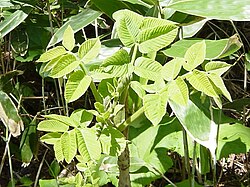| Toxicodendron vernicifluum | |
|---|---|
 | |
| Scientific classification | |
| Kingdom: | Plantae |
| Clade: | Tracheophytes |
| Clade: | Angiosperms |
| Clade: | Eudicots |
| Clade: | Rosids |
| Order: | Sapindales |
| Family: | Anacardiaceae |
| Genus: | Toxicodendron |
| Species: | T. vernicifluum |
| Binomial name | |
| Toxicodendron vernicifluum (Stokes) F. A. Barkley | |



Toxicodendron vernicifluum (formerly Rhus verniciflua [1] ), also known by the common name Chinese lacquer tree, [1] [2] [3] is an Asian tree species of genus Toxicodendron native to China and the Indian subcontinent, and cultivated in regions of China, Japan and Korea. [4] Other common names include poison sumac, Japanese lacquer tree, [5] Japanese sumac, [4] and varnish tree. [5] The trees are cultivated and tapped for their toxic sap, which is used as a highly durable lacquer to make Chinese, Japanese, and Korean lacquerware.
Contents
The trees grow up to 20 metres tall with large leaves, each containing from 7 to 19 leaflets (most often 11–13). The sap contains the allergenic compound urushiol, which gets its name from this species' Japanese name urushi (urushi (漆)); "urushi" is also used in English as a collective term for all kinds of Asian lacquerware made from the sap of this and related Asian tree species, as opposed to European "lacquer" or Japanning made from other materials. Urushiol is also the oil found in poison ivy and poison oak, to which the tree is related, that causes a rash.